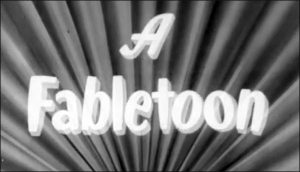
First, in Thunderbean news:
I’ve had my head wrapped around the Little King set perhaps a little too much. It’s nearly done and, as with Flip, is waiting for one more thing as I make the final edit togethers of each film. I may resort to gift baskets sent daily for these two projects. There’s a world famous place here in Ann Arbor called Zingerman’s that makes an amazing variety of food products, so a basket from them would probably make anyone happy. If that doesn’t work we’ll just have to move both projects forward into replication without these key things. Here’s a picture of their “Weekender” gift box. Wish me luck!

Each week as I’m working on something to show or talk about I end up looking through various hard drives- and always stumble upon this or that to show. Since I’ve been in Van Beuren land a lot lately I thought I’d stray far away from showing something not related to that studio, but as I was looking for something fun to show, the soundtrack here made me laugh out loud again- and it feels like a good week to laugh at something silly. The HD scan looks much better than the one we showed many, many years back.
 A Lad and His Lamp appears to be one of two silent Aesop’s Fables cartoons dubbed by ‘Film Highlights’ to distribute in 16mm. I wish they had done 100. Unlike the other film in this soundtracked series, The Black Duck, they credit Paul Terry — and they’ve given Winston Sharples the credit for the track. I’ve always assumed the track was stock music, but upon listening I don’t recognize it from anything else. It could be stock music by Sharples or written just for this short. It certainly sounds much more like it’s from the 30s than the 40s and thematically follows certain scenes as if it was written for this short. What do you think?
A Lad and His Lamp appears to be one of two silent Aesop’s Fables cartoons dubbed by ‘Film Highlights’ to distribute in 16mm. I wish they had done 100. Unlike the other film in this soundtracked series, The Black Duck, they credit Paul Terry — and they’ve given Winston Sharples the credit for the track. I’ve always assumed the track was stock music, but upon listening I don’t recognize it from anything else. It could be stock music by Sharples or written just for this short. It certainly sounds much more like it’s from the 30s than the 40s and thematically follows certain scenes as if it was written for this short. What do you think?
Happily, it’s just as saucy in its animation and humor as I remember. The silent fables are at times some of the most fun cartoons from the 20s and seem to thrive on their slightly subversive humor. As Chris Buchman would say, they are full of “worldly animals”. The “Pick up your head!” line is still my favorite thing in the whole film. It seems pretty clear that whoever did the voices were not professional voice artists. There’s another section where a hippo is yelling help to get out of a steam bath contraption, and the resulting track reminds me a lot of John Hubley’s soundtrack direction. Every line is delivered pretty strange. It’s great in its bizarreness.
When I wrote about this and The Black Duck here 9 years back, Don Yowp, always great with research, found an article with the announcement of the ‘Fabletoons’ series ion 1946:
“Here’s a bit about the releasing company, from ‘The Film Daily,’ Jan. 10, 1946:
ROSS LEAVES FILMS, INC. TO ESTABLISH OWN FIRM
Martin Ross, for the past 10 years associated with Films, Inc. as a sales executive, has formed his own company for the production and distribution of 16 mm. and 8 mm. sound and silent short subjects. The company will operate under the name of Film Highlights, Inc. at 330 W. 42nd St., New York City. Maj. Manny Jacobs, recently discharged from the Army Signal Corps, motion picture division, will be in charge of production.
Television was still fairly nascent so it could be they were for home viewing.”
Here’s that article from back then.
I’ve only seen this one and The Black Duck prints of these two have shown up multiple times thought the years. I have no idea if they did more in the series.
Have a good week everyone!


 Steve Stanchfield is an animator, educator and film archivist. He runs Thunderbean Animation, an animation studio in Ann Arbor, Michigan and has compiled over a dozen archival animation DVD collections devoted to such subjects at Private Snafu, The Little King and the infamous Cubby Bear. Steve is also a professor at the College for Creative Studies in Detroit.
Steve Stanchfield is an animator, educator and film archivist. He runs Thunderbean Animation, an animation studio in Ann Arbor, Michigan and has compiled over a dozen archival animation DVD collections devoted to such subjects at Private Snafu, The Little King and the infamous Cubby Bear. Steve is also a professor at the College for Creative Studies in Detroit.






















I love the Fabletoons! The “And in the springtime” ending would later be repeated in “Farmer Al Falfa’s Ape Girl” and “Club Life in the Stone Age”, complete with Mendelssohn’s Spring Song. I’d like to see more of the silent Fables cartoons furnished with music, voices and sound effects — that is, if they could be done as well as this one!
Having not seen “The Black Duck”, was Winston Sharples involved with that one as well?
Note the blood-dripping sword at about 04:35! Also, love the voice of the cat King.
I wish I had a Fabletoon print of either cartoon, I love these soundtracks since I first heard them on another CR Post years ago! Looks like they printed the track on a 35mm source; the image seems to be cropped from SOF. I believe Tommy Stathes at somepoint told me he had a print of this one with the original titles, which is really cool because when he puts it out on a Fables set, it’ll likely look sharper AND have a fantastic soundtrack to boot! Whatever it is, I’m happy to see these lovely Aesop Fables and I’m excited we’re on the verge of more becoming available!
What does SOF stand for? Some other film? Same old film? Shove off, fathead? I never collected film prints and am unfamiliar with all the technical acronyms.
Sound On Film… I believe.
Wow. Even as a small child, I thought of Terrytoons as rather dull & pedestrian, but this one is so delightfully bizarre! Thanks!
I know Zingerman’s well; they’re the only place that sells liptauer cheese spread, a favorite of an artist friend of mine.
Series idea: Mystery Cartoon Theater 3000.
The audio is too well synched to the action to be stock music. I would think this was written for the short. I really enjoyed this one. And I really liked the voices (professional or not). I also love the dream logic that it employs. One minute we are following a hippo on a quest to lose weight and then we are following a mouse on his quest to get his girl back.
Having a great list of the copyright dialogs to the silent Fables of this point and seeing a few prints personally from some exhibitions, I can say that the silent Fables are probably peak silent cartoon comedy. Not exactly in the creative sense like Fleischer, or in the cute, imaginative sense like Messmer, but rather in the sense that it is funny, bizarre, and relatable. Even when the themes get repetitive, somehow the silent Fables still remain hilariously over the top, unlike in a Terrytoon it can either hit or miss– or a lot. Even the tamest, or the most repetitive, or the most mediocre of silent Fables entries can have some good build up. Most of the poor, ancient copies on YouTube do it a disservice.
This Fable here was directed by Frank Moser, and appears to be animated mostly by him. The late ones from early 1926 to mid 1929 are particularly some of the most grating and interesting ones due to Paul lending most of the direction work to his top five animators: Jerry Shields, Frank Moser, John Foster, Mannie Davis, and Harry Bailey. This resulted in something somewhat similar to what you would eventually see in Warners’ very own Termite Terrace organization. Bill Tytla also does great handiwork with the later Fables, predating overlapped animation.
Eventually, Terry went back to being sole director at Terrytoons, with however Moser as his assistant– hence the fast, cheap signature quality of Moser’s penwork (characters doing an instant cut to the next background, very slick and quick drawings, etc) remained, which Terry, of course, liked. All the Fables copyright synopses from up to 1927 can be viewed online at the Library of Congress.
Nice copy of this Aesop’s Film Fable, Steve. Not centered of course, and no moral at the end. Voices were hilarious, “Pick Up Your Head!”, best line in the show.
Thanks for posting this.
Mark
Oh dagnab I thought it was Bugs Bunny.
I wonder what audiences in 1947 responded to an 18 year old film? And how it compared to how a modern audience would react to a work from the mid-00s? (Yes, I’m sorry to break it to you, and me, but that is the equivalent period of time now)
Crazy man. Flip city! “pick up your head” HA!
As I posted elsewhere, Steve – I’m a little “under the weather” today (bronchitis or a bad cold), so I’m not exactly clear if these FABLETOON cartoons were made for 16mm film rental use exclusively, or were they shown in (probably) neighborhood theaters used to “second-runs” or “re-releases” of older – and cheaper to rent – films. My dad used to go to a theater in Chicago – called The Roscoe – near Riverview Park that showed older Western films – almost exclusively. I asked my dad once who some of his favorite Western stars were. I expected him to say something like “John Wayne.” But one of his favorites as youngster was Tom Mix. I said, “Dad, Tom Mix died when you were still in grade school!” Well, he patiently explained to me that this theater showed older films to kids – because they were much cheaper to rent – and very profitable. So, I’m wondering if these cartoons may have been run in theaters back in the later ’40s?
This also reminds me of the questions regarding THE FRESH LOBSTER (c. 1928) – and its origin. I think film historian Richard Roberts is correct in placing that short in the early or middle 1930s, rather than 1928 – due to the age of Bletcher at the time and the vintage of some of the cars, one which he says is a 1931 Model A Ford. Again, did these few existing FABLETOONS have a theatrical release or were they made strictly for film rentals or possible television release? Regarding Winston Sharples, remember that he worked on putting scores on older films in the ’30s – Chaplin’s Mutual comedy shorts, for example. He may have scored the film for a re-issue in the 1930s and the cartoon may have sat on “a shelf” in a film archive for years, before it was released.